Cybercrime Report: In-depth Analysis of Sony Hacks and Nigerian Scams
VerifiedAdded on 2021/08/16
|6
|1332
|63
Report
AI Summary
This report provides a comprehensive analysis of two significant cybercrime incidents: the Sony Pictures Entertainment hack and Nigerian scams. The Sony hack, attributed to the Guardians of Peace, a group believed to be backed by North Korea, involved the theft and public release of sensitive data, causing significant financial and reputational damage. The report details the hackers' use of phishing, social engineering, and potential vulnerabilities in Sony's network security. The second part of the report examines Nigerian scams, also known as 419 scams, where fraudsters use social engineering, phishing, and psychological manipulation to deceive victims into transferring money. The report explores the methods employed by scammers, including fake emails, promises of rewards, and the use of viruses and Trojans to steal personal and financial information. It also highlights the adverse consequences of these scams, including financial loss, identity theft, and increased criminal activities. The report references the lack of security measures taken by Sony and the psychological tactics employed by the Nigerian scammers, offering a detailed overview of these cyber threats.
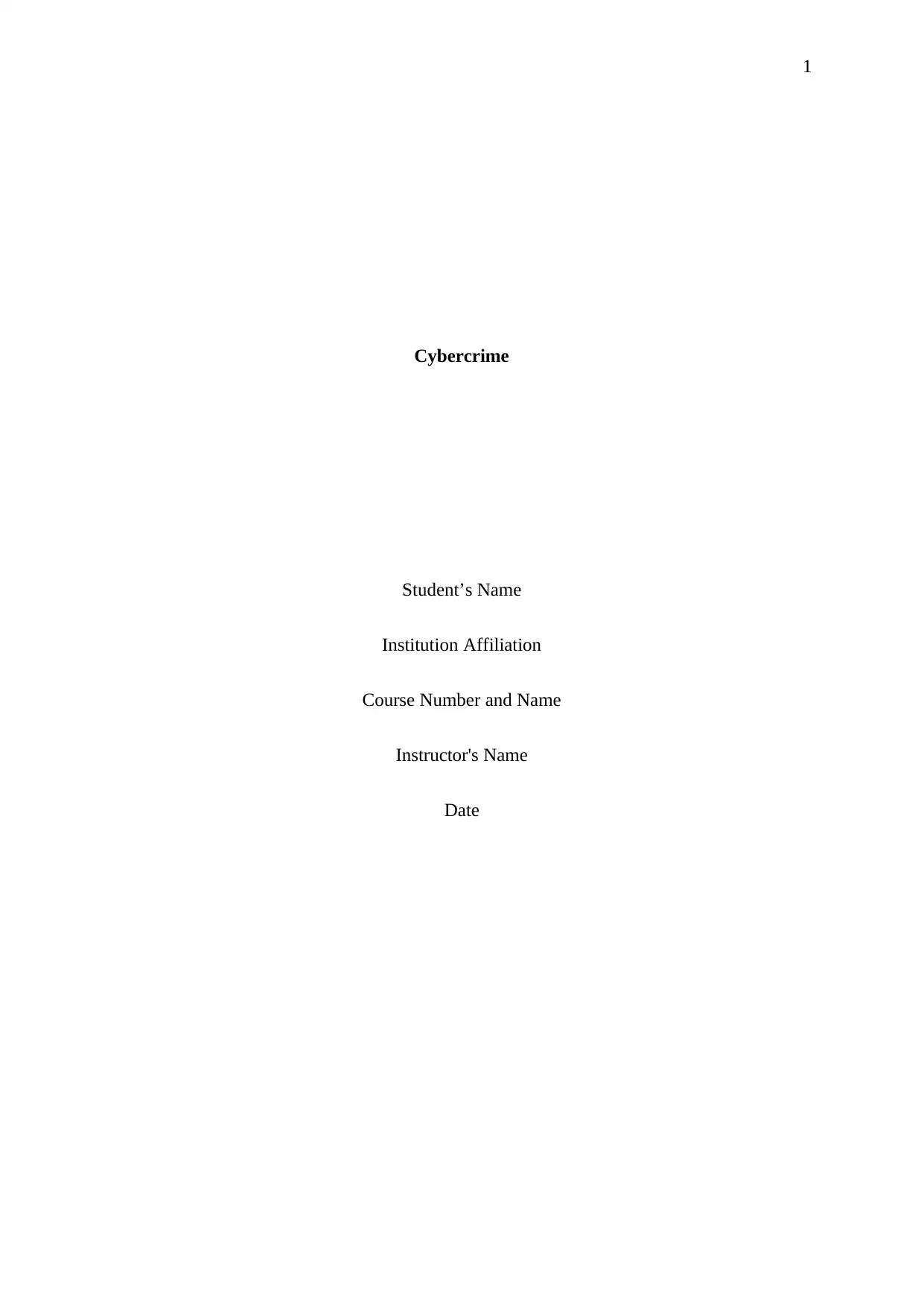
1
Cybercrime
Student’s Name
Institution Affiliation
Course Number and Name
Instructor's Name
Date
Cybercrime
Student’s Name
Institution Affiliation
Course Number and Name
Instructor's Name
Date
Paraphrase This Document
Need a fresh take? Get an instant paraphrase of this document with our AI Paraphraser
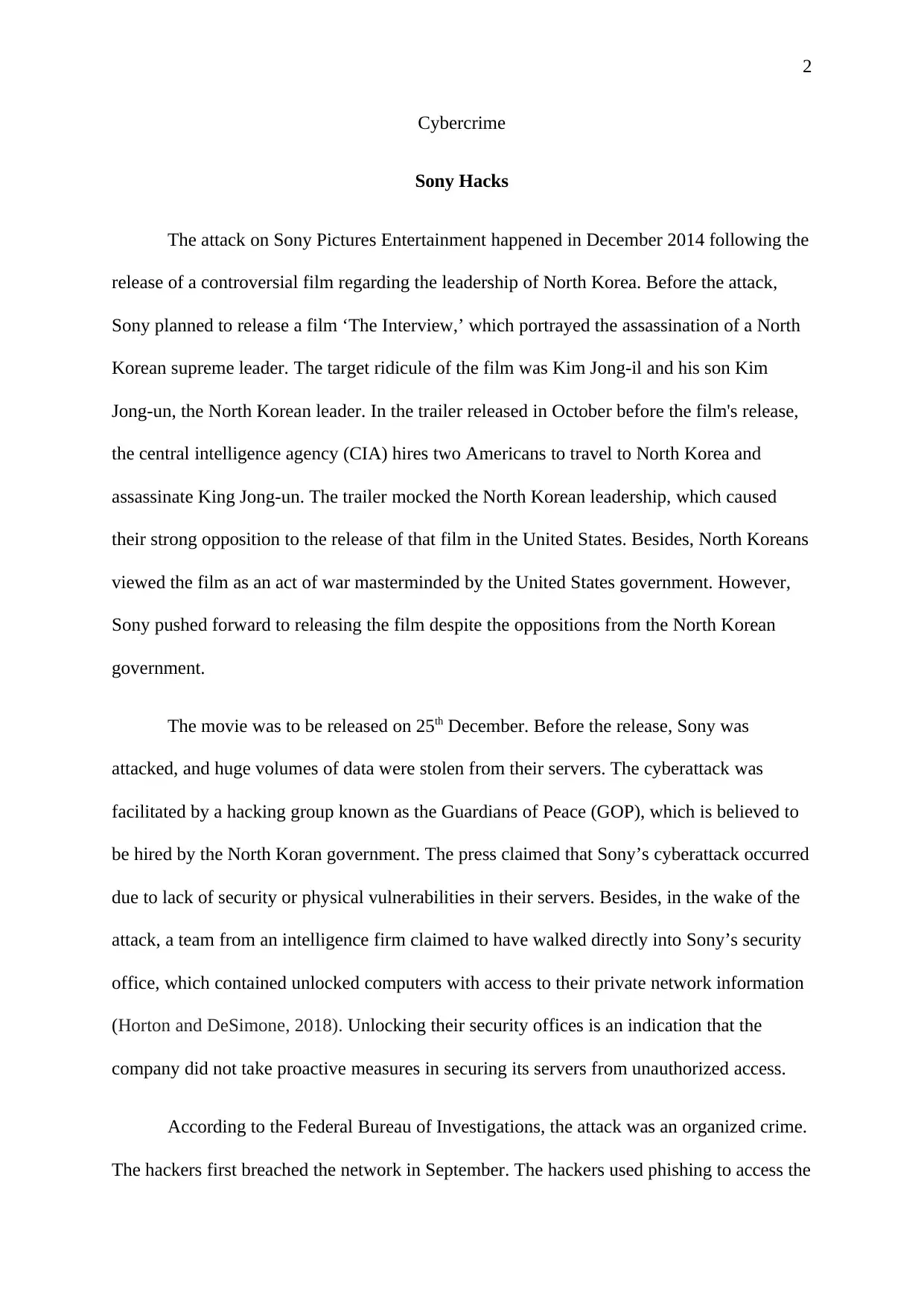
2
Cybercrime
Sony Hacks
The attack on Sony Pictures Entertainment happened in December 2014 following the
release of a controversial film regarding the leadership of North Korea. Before the attack,
Sony planned to release a film ‘The Interview,’ which portrayed the assassination of a North
Korean supreme leader. The target ridicule of the film was Kim Jong-il and his son Kim
Jong-un, the North Korean leader. In the trailer released in October before the film's release,
the central intelligence agency (CIA) hires two Americans to travel to North Korea and
assassinate King Jong-un. The trailer mocked the North Korean leadership, which caused
their strong opposition to the release of that film in the United States. Besides, North Koreans
viewed the film as an act of war masterminded by the United States government. However,
Sony pushed forward to releasing the film despite the oppositions from the North Korean
government.
The movie was to be released on 25th December. Before the release, Sony was
attacked, and huge volumes of data were stolen from their servers. The cyberattack was
facilitated by a hacking group known as the Guardians of Peace (GOP), which is believed to
be hired by the North Koran government. The press claimed that Sony’s cyberattack occurred
due to lack of security or physical vulnerabilities in their servers. Besides, in the wake of the
attack, a team from an intelligence firm claimed to have walked directly into Sony’s security
office, which contained unlocked computers with access to their private network information
(Horton and DeSimone, 2018). Unlocking their security offices is an indication that the
company did not take proactive measures in securing its servers from unauthorized access.
According to the Federal Bureau of Investigations, the attack was an organized crime.
The hackers first breached the network in September. The hackers used phishing to access the
Cybercrime
Sony Hacks
The attack on Sony Pictures Entertainment happened in December 2014 following the
release of a controversial film regarding the leadership of North Korea. Before the attack,
Sony planned to release a film ‘The Interview,’ which portrayed the assassination of a North
Korean supreme leader. The target ridicule of the film was Kim Jong-il and his son Kim
Jong-un, the North Korean leader. In the trailer released in October before the film's release,
the central intelligence agency (CIA) hires two Americans to travel to North Korea and
assassinate King Jong-un. The trailer mocked the North Korean leadership, which caused
their strong opposition to the release of that film in the United States. Besides, North Koreans
viewed the film as an act of war masterminded by the United States government. However,
Sony pushed forward to releasing the film despite the oppositions from the North Korean
government.
The movie was to be released on 25th December. Before the release, Sony was
attacked, and huge volumes of data were stolen from their servers. The cyberattack was
facilitated by a hacking group known as the Guardians of Peace (GOP), which is believed to
be hired by the North Koran government. The press claimed that Sony’s cyberattack occurred
due to lack of security or physical vulnerabilities in their servers. Besides, in the wake of the
attack, a team from an intelligence firm claimed to have walked directly into Sony’s security
office, which contained unlocked computers with access to their private network information
(Horton and DeSimone, 2018). Unlocking their security offices is an indication that the
company did not take proactive measures in securing its servers from unauthorized access.
According to the Federal Bureau of Investigations, the attack was an organized crime.
The hackers first breached the network in September. The hackers used phishing to access the
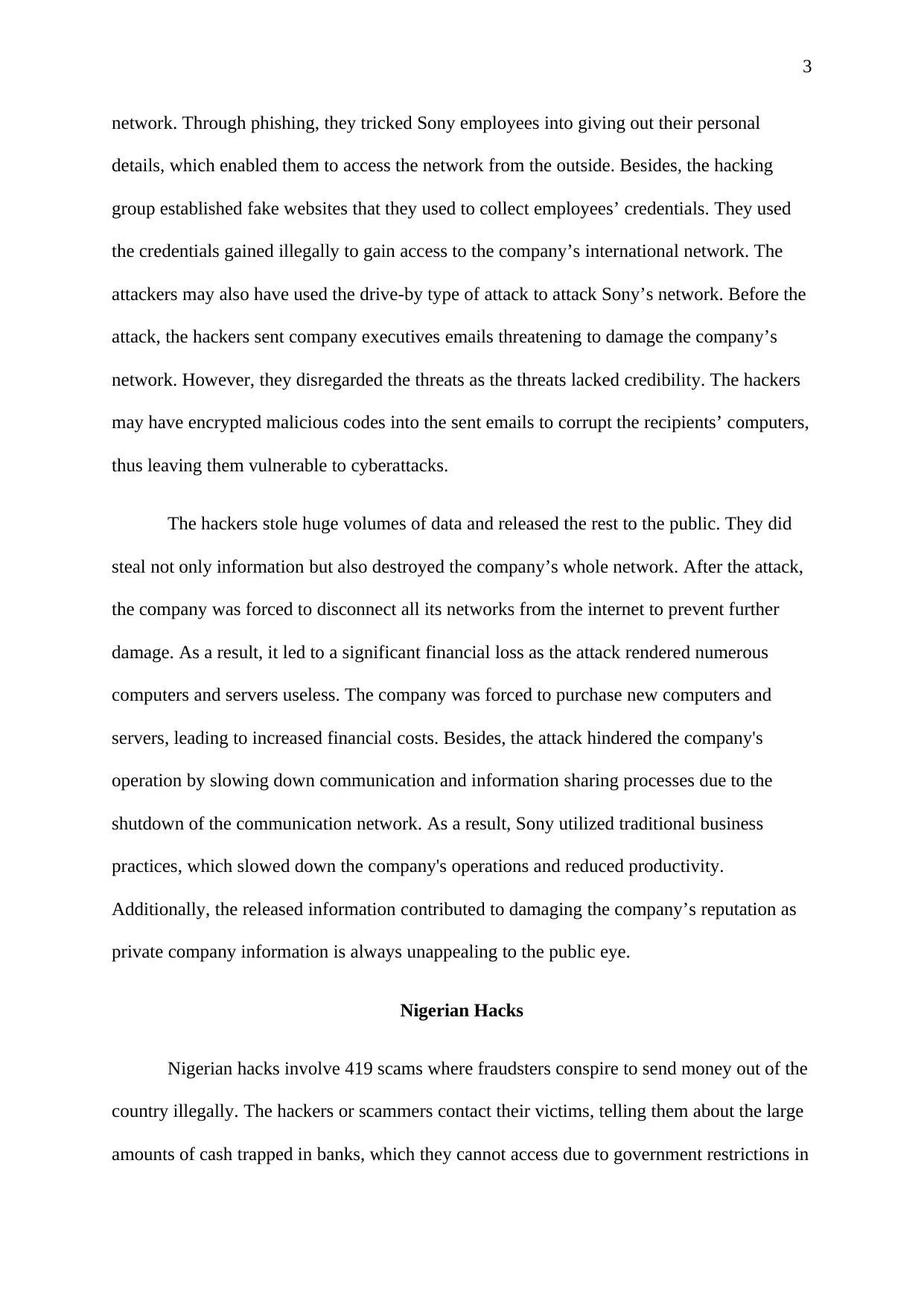
3
network. Through phishing, they tricked Sony employees into giving out their personal
details, which enabled them to access the network from the outside. Besides, the hacking
group established fake websites that they used to collect employees’ credentials. They used
the credentials gained illegally to gain access to the company’s international network. The
attackers may also have used the drive-by type of attack to attack Sony’s network. Before the
attack, the hackers sent company executives emails threatening to damage the company’s
network. However, they disregarded the threats as the threats lacked credibility. The hackers
may have encrypted malicious codes into the sent emails to corrupt the recipients’ computers,
thus leaving them vulnerable to cyberattacks.
The hackers stole huge volumes of data and released the rest to the public. They did
steal not only information but also destroyed the company’s whole network. After the attack,
the company was forced to disconnect all its networks from the internet to prevent further
damage. As a result, it led to a significant financial loss as the attack rendered numerous
computers and servers useless. The company was forced to purchase new computers and
servers, leading to increased financial costs. Besides, the attack hindered the company's
operation by slowing down communication and information sharing processes due to the
shutdown of the communication network. As a result, Sony utilized traditional business
practices, which slowed down the company's operations and reduced productivity.
Additionally, the released information contributed to damaging the company’s reputation as
private company information is always unappealing to the public eye.
Nigerian Hacks
Nigerian hacks involve 419 scams where fraudsters conspire to send money out of the
country illegally. The hackers or scammers contact their victims, telling them about the large
amounts of cash trapped in banks, which they cannot access due to government restrictions in
network. Through phishing, they tricked Sony employees into giving out their personal
details, which enabled them to access the network from the outside. Besides, the hacking
group established fake websites that they used to collect employees’ credentials. They used
the credentials gained illegally to gain access to the company’s international network. The
attackers may also have used the drive-by type of attack to attack Sony’s network. Before the
attack, the hackers sent company executives emails threatening to damage the company’s
network. However, they disregarded the threats as the threats lacked credibility. The hackers
may have encrypted malicious codes into the sent emails to corrupt the recipients’ computers,
thus leaving them vulnerable to cyberattacks.
The hackers stole huge volumes of data and released the rest to the public. They did
steal not only information but also destroyed the company’s whole network. After the attack,
the company was forced to disconnect all its networks from the internet to prevent further
damage. As a result, it led to a significant financial loss as the attack rendered numerous
computers and servers useless. The company was forced to purchase new computers and
servers, leading to increased financial costs. Besides, the attack hindered the company's
operation by slowing down communication and information sharing processes due to the
shutdown of the communication network. As a result, Sony utilized traditional business
practices, which slowed down the company's operations and reduced productivity.
Additionally, the released information contributed to damaging the company’s reputation as
private company information is always unappealing to the public eye.
Nigerian Hacks
Nigerian hacks involve 419 scams where fraudsters conspire to send money out of the
country illegally. The hackers or scammers contact their victims, telling them about the large
amounts of cash trapped in banks, which they cannot access due to government restrictions in
⊘ This is a preview!⊘
Do you want full access?
Subscribe today to unlock all pages.

Trusted by 1+ million students worldwide
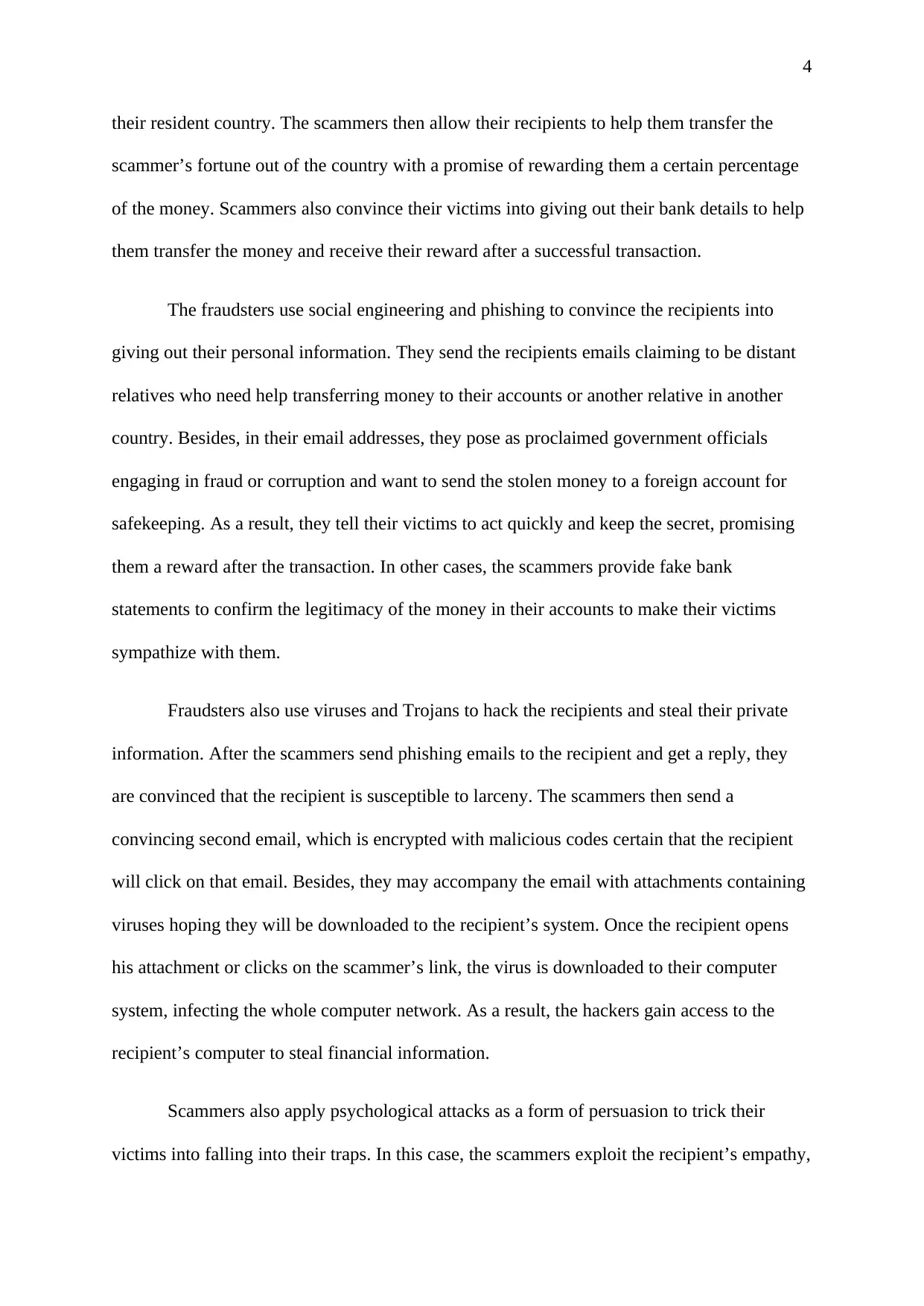
4
their resident country. The scammers then allow their recipients to help them transfer the
scammer’s fortune out of the country with a promise of rewarding them a certain percentage
of the money. Scammers also convince their victims into giving out their bank details to help
them transfer the money and receive their reward after a successful transaction.
The fraudsters use social engineering and phishing to convince the recipients into
giving out their personal information. They send the recipients emails claiming to be distant
relatives who need help transferring money to their accounts or another relative in another
country. Besides, in their email addresses, they pose as proclaimed government officials
engaging in fraud or corruption and want to send the stolen money to a foreign account for
safekeeping. As a result, they tell their victims to act quickly and keep the secret, promising
them a reward after the transaction. In other cases, the scammers provide fake bank
statements to confirm the legitimacy of the money in their accounts to make their victims
sympathize with them.
Fraudsters also use viruses and Trojans to hack the recipients and steal their private
information. After the scammers send phishing emails to the recipient and get a reply, they
are convinced that the recipient is susceptible to larceny. The scammers then send a
convincing second email, which is encrypted with malicious codes certain that the recipient
will click on that email. Besides, they may accompany the email with attachments containing
viruses hoping they will be downloaded to the recipient’s system. Once the recipient opens
his attachment or clicks on the scammer’s link, the virus is downloaded to their computer
system, infecting the whole computer network. As a result, the hackers gain access to the
recipient’s computer to steal financial information.
Scammers also apply psychological attacks as a form of persuasion to trick their
victims into falling into their traps. In this case, the scammers exploit the recipient’s empathy,
their resident country. The scammers then allow their recipients to help them transfer the
scammer’s fortune out of the country with a promise of rewarding them a certain percentage
of the money. Scammers also convince their victims into giving out their bank details to help
them transfer the money and receive their reward after a successful transaction.
The fraudsters use social engineering and phishing to convince the recipients into
giving out their personal information. They send the recipients emails claiming to be distant
relatives who need help transferring money to their accounts or another relative in another
country. Besides, in their email addresses, they pose as proclaimed government officials
engaging in fraud or corruption and want to send the stolen money to a foreign account for
safekeeping. As a result, they tell their victims to act quickly and keep the secret, promising
them a reward after the transaction. In other cases, the scammers provide fake bank
statements to confirm the legitimacy of the money in their accounts to make their victims
sympathize with them.
Fraudsters also use viruses and Trojans to hack the recipients and steal their private
information. After the scammers send phishing emails to the recipient and get a reply, they
are convinced that the recipient is susceptible to larceny. The scammers then send a
convincing second email, which is encrypted with malicious codes certain that the recipient
will click on that email. Besides, they may accompany the email with attachments containing
viruses hoping they will be downloaded to the recipient’s system. Once the recipient opens
his attachment or clicks on the scammer’s link, the virus is downloaded to their computer
system, infecting the whole computer network. As a result, the hackers gain access to the
recipient’s computer to steal financial information.
Scammers also apply psychological attacks as a form of persuasion to trick their
victims into falling into their traps. In this case, the scammers exploit the recipient’s empathy,
Paraphrase This Document
Need a fresh take? Get an instant paraphrase of this document with our AI Paraphraser
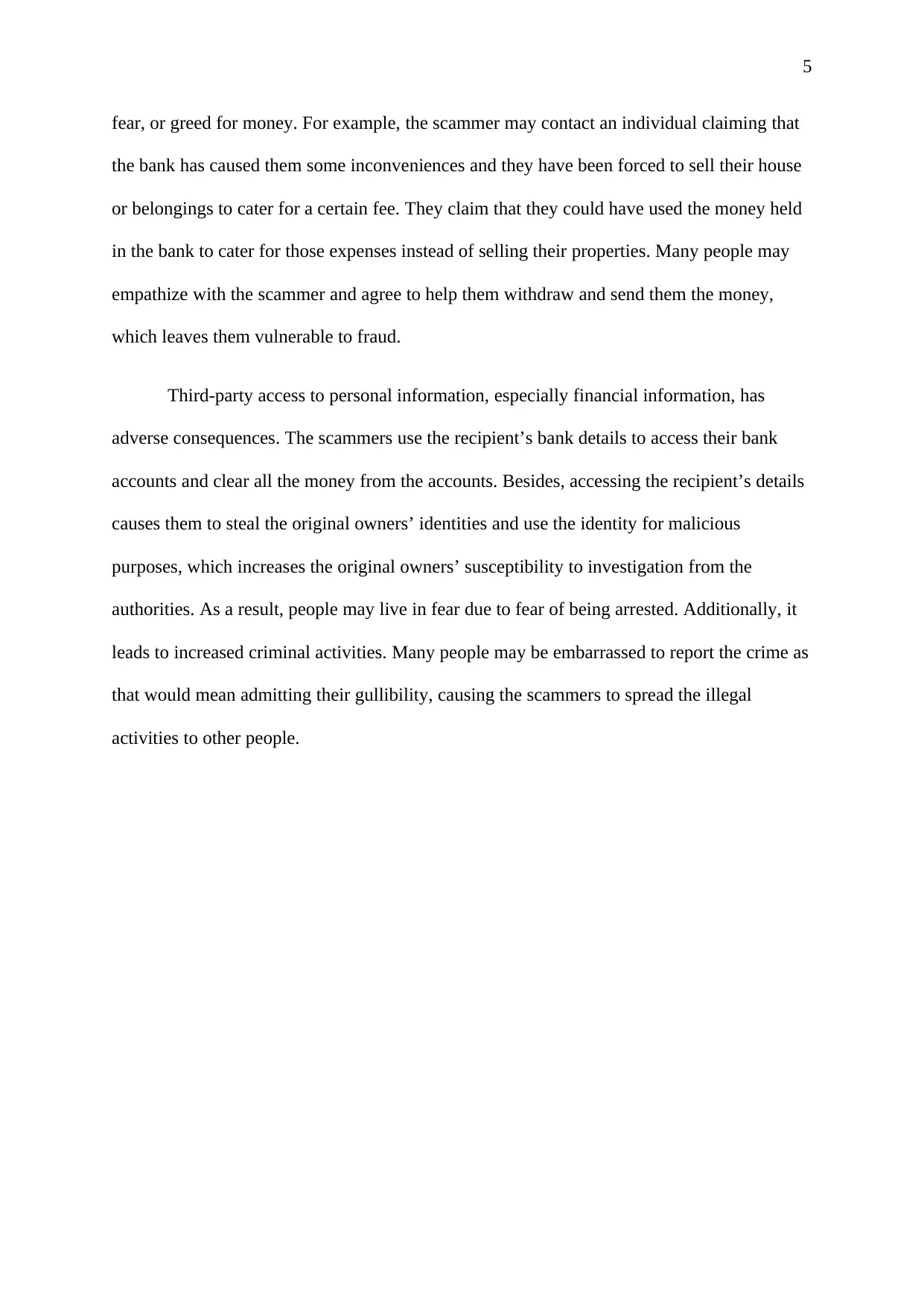
5
fear, or greed for money. For example, the scammer may contact an individual claiming that
the bank has caused them some inconveniences and they have been forced to sell their house
or belongings to cater for a certain fee. They claim that they could have used the money held
in the bank to cater for those expenses instead of selling their properties. Many people may
empathize with the scammer and agree to help them withdraw and send them the money,
which leaves them vulnerable to fraud.
Third-party access to personal information, especially financial information, has
adverse consequences. The scammers use the recipient’s bank details to access their bank
accounts and clear all the money from the accounts. Besides, accessing the recipient’s details
causes them to steal the original owners’ identities and use the identity for malicious
purposes, which increases the original owners’ susceptibility to investigation from the
authorities. As a result, people may live in fear due to fear of being arrested. Additionally, it
leads to increased criminal activities. Many people may be embarrassed to report the crime as
that would mean admitting their gullibility, causing the scammers to spread the illegal
activities to other people.
fear, or greed for money. For example, the scammer may contact an individual claiming that
the bank has caused them some inconveniences and they have been forced to sell their house
or belongings to cater for a certain fee. They claim that they could have used the money held
in the bank to cater for those expenses instead of selling their properties. Many people may
empathize with the scammer and agree to help them withdraw and send them the money,
which leaves them vulnerable to fraud.
Third-party access to personal information, especially financial information, has
adverse consequences. The scammers use the recipient’s bank details to access their bank
accounts and clear all the money from the accounts. Besides, accessing the recipient’s details
causes them to steal the original owners’ identities and use the identity for malicious
purposes, which increases the original owners’ susceptibility to investigation from the
authorities. As a result, people may live in fear due to fear of being arrested. Additionally, it
leads to increased criminal activities. Many people may be embarrassed to report the crime as
that would mean admitting their gullibility, causing the scammers to spread the illegal
activities to other people.
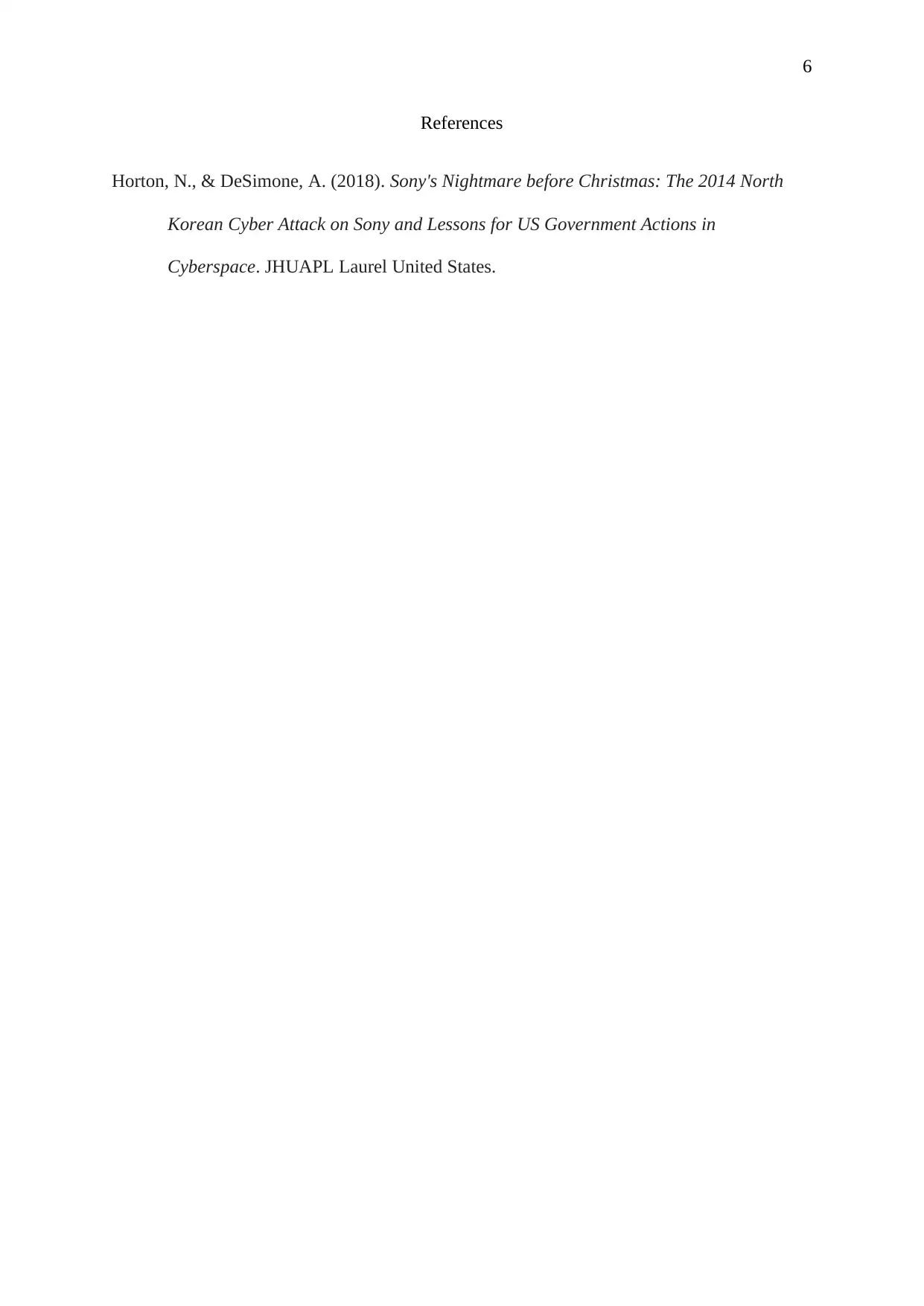
6
References
Horton, N., & DeSimone, A. (2018). Sony's Nightmare before Christmas: The 2014 North
Korean Cyber Attack on Sony and Lessons for US Government Actions in
Cyberspace. JHUAPL Laurel United States.
References
Horton, N., & DeSimone, A. (2018). Sony's Nightmare before Christmas: The 2014 North
Korean Cyber Attack on Sony and Lessons for US Government Actions in
Cyberspace. JHUAPL Laurel United States.
⊘ This is a preview!⊘
Do you want full access?
Subscribe today to unlock all pages.

Trusted by 1+ million students worldwide
1 out of 6
Your All-in-One AI-Powered Toolkit for Academic Success.
+13062052269
info@desklib.com
Available 24*7 on WhatsApp / Email
![[object Object]](/_next/static/media/star-bottom.7253800d.svg)
Unlock your academic potential
Copyright © 2020–2025 A2Z Services. All Rights Reserved. Developed and managed by ZUCOL.

